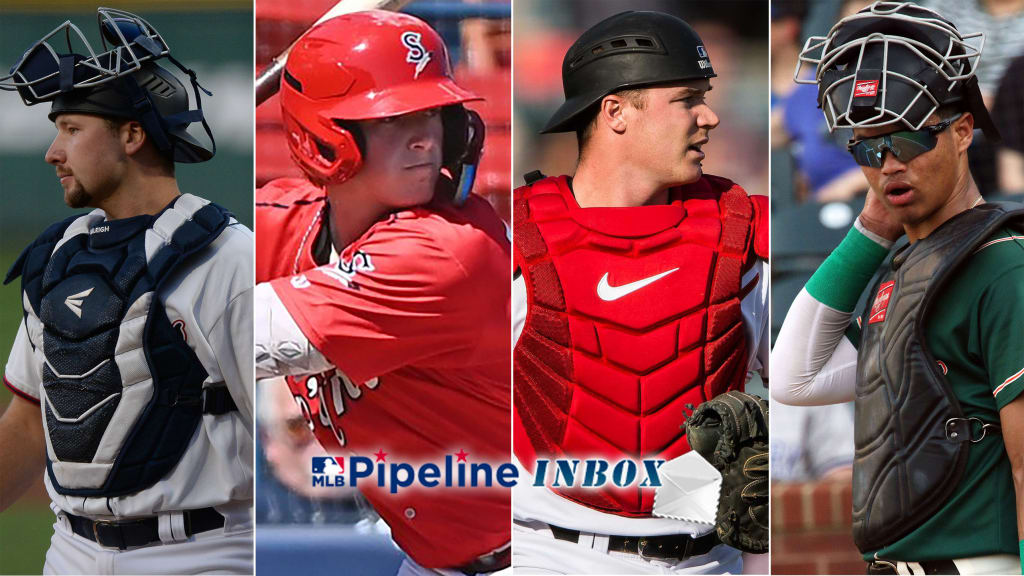
To me, finding and developing good catching prospect might be the toughest thing to do in the scouting/player development world. I know, pitching is so risky, but a catcher has to be able to do so many things well to be a legitimate big league starter, and how many of those are truly elite on both sides of the ball these days?
I bring this up because I got a number of catching-related questions for this week’s MLB Pipeline Inbox, and who doesn’t like a themed Inbox, right? Be sure to check out this week’s MLB Pipeline Podcast, where we answer a non-catching question about the impact September callups can have on rankings. For now, though, let’s move behind the plate.
Cal Raleigh was never a top catching prospect, but yet he's one of the best catchers in all of baseball right now. (Leads 1 of the best SP rotation and lead all Catchers in HR) Can you talk about his development and why he was overlooked? -- @Ms4Life_
While Raleigh never was on our Top 10 catchers list, he was in the Mariners’ Top 10 when he graduated off in 2021. He topped out at No. 8 based on his tools and projections of his future. And while you’re right that he is one of the better catchers in the big leagues -- he’s fifth among MLB catchers with 3.5 bWAR -- this year, looking back at his reports in 2020 and 2021, I think we were pretty spot on.
First, looking at his grades, we had him as a power-over-hit guy (45 hit, 60 power) and that’s certainly played out. As you pointed out, he leads catchers with 23 homers, but he’s still struggled with his approach -- his 28.3 percent strikeout rate is above league average -- and has hit .210. Check off that box.
In both years, we talked about how great he was in working with Mariners’ pitchers. His 3.12 catchers’ ERA is better than any of the big league backstops ranking ahead of him in bWAR. He’s second in the big leagues in rCERA (runs saved by affecting the pitcher’s ERA, IOW, effects on game calling). Check off that box.
We raved about his receiving metrics and blocking skills. Check off that box.
We talked about how hard he worked to improve his arm strength and how accurate he was in the Minors. Despite not having a cannon, he’s thrown out 31 percent of potential basestealers in the big leagues. Check off that box.
Our final assessment as that he had the ceiling to be a big league starter, and that’s exactly what he’s become. Should he have been among our Top 10 catching prospects in hindsight? Perhaps. But while I’m always willing to admit when we got someone wrong (in either direction), in this case, we got Raleigh right.
What are your thoughts on Hunter Goodman? He leads the Minors in homers but has been older than the majority of his competition this year. -- @MardindaShovel
Goodman was the Rockies’ fourth-round pick out of the University of Memphis in 2021, one who showed off his power potential throughout his college career, including hitting 21 homers in his Draft season. The reason he didn’t go until the fourth round was because of concerns about his hit tool -- would he make enough contact to get to that power at the next level -- and if he could stick behind the plate. And that’s why he’s currently No. 23 on the Rockies’ Top 30. This first full season of pro ball has seemingly answered the first question, even if he started out at a level lower than he should have been bat-wise.
Goodman spent 73 games with Single-A Fresno, hitting 22 homers and slugging .592. I think it’s safe to assume he stayed at that level as long as he did to work on the defensive side of things. Though he played more first base than games he caught, he was working tirelessly on his defense behind the plate.
As someone who was power-over-hit, strength-over-bat speed coming out, Goodman needed to show he could still reach the seats against better competition. He did that in Spokane, with 12 homers and a .589 SLG in 49 games, and he was no longer “old for his level.” Again, he logged more games at first than behind the dish, but the Rockies feel his throwing -- he’s thrown out 30 percent of potential basestealers this year -- and receiving are much improved, and he’s worked on his defense at first as well.
Now he’s in the Double-A Eastern League, the real test, where he’s nearly two years younger than the average hitter. It won’t be a huge sample size there, but it’s good to see that he’s where he should be. Overall, his line is very impressive at .298/.359/.585 with the 34 homers you mentioned and 102 RBIs. I’m beginning to think the bat is going to play, to an extent. While his strikeout rate isn’t terrible (25.8 percent) given his power output, his overly aggressive approach (139 K/38 BB) points to him fulfilling his power-over-hit profile. But hey, teams these days don’t mind that, right?
And while the Rockies are pleased with his progress defensively, I’m not sure he’s going to be a big league regular there. Maybe he’s the type who plays a lot of first base and DH and serves as the backup catcher, or a third catcher. The right-right profile is a tough one at first, but if he shows the power at the upper levels in 2023, he has the chance to have enough pop to be a regular there.
Who is the future catcher for the Pittsburgh Pirates -- Henry Davis or Endy Rodriguez? -- @PiratesFanDan
I know I just answered a question about Endy Rodriguez last week (he’s become a favorite “When will he be on the Top 100?” target), but this one is pretty interesting.
Davis, of course, was the No. 1 pick in last year’s Draft, and he’s currently the Pirates’ No. 1 prospect, and No. 20 on the Top 100. His biggest issue in his first full season has been staying healthy, as he’s played in just 51 games as his left wrist has landed him on the injured list more than once. He’s been hit by a pitch 18 times in 221 plate appearances. That’s cost him reps both at and behind the plate and as someone whose receiving was a little bit of a question mark entering pro ball (his 70 arm works just fine), he needs that development time. When he’s been healthy he’s hit, though he’s readjusting slowly in Double-A at the end of this season.
Rodriguez has hit all year, and those of us who wanted to see him put up numbers away from hitter-friendly Greensboro have now seen it for long enough to believe, as he has an 1.194 OPS in 23 games with Altoona. He’s caught more than anything else (67 games), but he’s also played a good amount of second base (16 games) and the outfield (13 games). That speaks volumes about his athleticism and versatility, and it also was necessary at times to move him around because he was at the same level as Davis and even Abrahan Gutierriez, who’s still in Greensboro. But it’s also made it tough to know for sure if he can be a big league regular behind the plate.
Maybe the Pirates end up with a system where Davis and Rodriguez split catching duties in Pittsburgh, but their bats are in the lineup regularly. Davis is athletic enough to play elsewhere, though he hasn’t yet, and there’s the DH spot. I think Rodriguez has more upside as a defender overall, so if I had to pick one to be a big league starter behind the plate, it would be him. But I also know that Davis is the type to use this kind of evaluation as motivation to work harder at that part of his game and exceed expectations. The good news is I think both are going to hit and hit enough to profile well wherever they are penciled into a big league lineup.
